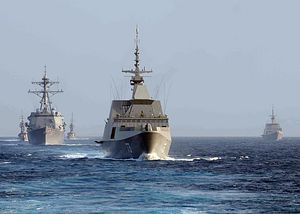In a direct public criticism of Chinese land reclamation in features in the South China Sea, America’s top Pacific commander accused Beijing of building a “great wall of sand” in disputed areas, media outlets reported March 31.
U.S. Pacific Fleet Commander Admiral Harry Harris Jr. reportedly told a gathering in Australia Tuesday that China’s unprecedented land reclamation activities – which had now created around 1.5 square miles of artificial land mass with construction still ongoing – raised serious doubts about Beijing’s future intentions.
“China is creating a great wall of sand with dredges and bulldozers over the course of months,” Harris said.
“When one looks at China’s pattern of provocative actions towards smaller claimant states, the lack of clarity on its sweeping nine dash line claim that is inconsistent with international law, and the deep asymmetry between China’s capabilities and those of its smaller neighbors—well, it’s no surprise that the scope and pace of building man-made islands raises serious questions about Chinese intentions.”
As The Diplomat has previously reported, several claimant states – most notably the Philippines – as well as external countries like the United States have expressed deep concern about China’s activities in the South China Sea on several features, including Fiery Cross Reef, Johnson South Reef and Gaven Reef. Analysts worry that Beijing is altering the status quo to realize its extensive nine-dash line claim and building up the capabilities to enforce a potential air defense identification zone (ADIZ) in the South China Sea, including a second airstrip.
Harris said the United States urged all claimants to conform to the 2002 ASEAN-China Declaration on the Conduct of Parties in the South China Sea, under which the parties committed to “exercise self-restraint in the conduct of activities that would complicate or escalate disputes and affect peace and stability.”
He also suggested that China’s activities in the South China Sea raised serious questions about its intentions and that Beijing’s future behavior would be a litmus test for broader regional peace and stability.
“How China proceeds will be a key indicator of whether the region is headed towards confrontation or cooperation,” he added.

































